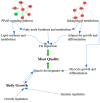RNA-Seq Reveals Pathways Responsible for Meat Quality Characteristic Differences between Two Yunnan Indigenous Chicken Breeds and Commercial Broilers
- PMID: 38998514
- PMCID: PMC11241438
- DOI: 10.3390/foods13132008
RNA-Seq Reveals Pathways Responsible for Meat Quality Characteristic Differences between Two Yunnan Indigenous Chicken Breeds and Commercial Broilers
Abstract
Poultry is a source of meat that is in great demand in the world. The quality of meat is an imperative point for shoppers. To explore the genes controlling meat quality characteristics, the growth and meat quality traits and muscle transcriptome of two indigenous Yunnan chicken breeds, Wuding chickens (WDs) and Daweishan mini chickens (MCs), were compared with Cobb broilers (CBs). The growth and meat quality characteristics of these two indigenous breeds were found to differ from CB. In particular, the crude fat (CF), inosine monophosphate content, amino acid (AA), and total fatty acid (TFA) content of WDs were significantly higher than those of CBs and MCs. In addition, it was found that MC pectoralis had 420 differentially expressed genes (DEGs) relative to CBs, and WDs had 217 DEGs relative to CBs. Among them, 105 DEGs were shared. The results of 10 selected genes were also confirmed by qPCR. The differentially expressed genes were six enriched Kyoto Encyclopedia of Genes and Genomes (KEGG) biological pathways including lysosomes, phagosomes, PPAR signaling pathways, cell adhesion molecules, cytokine-cytokine receptor interaction, and phagosome sphingolipid metabolism. Interestingly, four genes (LPL, GK, SCD, and FABP7) in the PPAR signal pathway related to fatty acid (FA) metabolism were elevated in WD muscles, which may account for higher CF, inosine monophosphate content, and AA and FA contents, key factors affecting meat quality. This work laid the foundation for improving the meat quality of Yunnan indigenous chickens, especially WD. In future molecular breeding, the genes in this study can be used as molecular screening markers and applied to the molecular breeding of chicken quality characteristics.
Keywords: RNA-Seq; chicken; differentially expressed genes; fat metabolism; meat quality characteristics.
Conflict of interest statement
The authors declare no conflicts of interest.
Figures








Similar articles
-
Integrating metabolomics and transcriptomics to analyze the differences of breast muscle quality and flavor formation between Daweishan mini chicken and broiler.Poult Sci. 2024 Aug;103(8):103920. doi: 10.1016/j.psj.2024.103920. Epub 2024 May 31. Poult Sci. 2024. PMID: 38909504 Free PMC article.
-
Transcriptomic analysis reveals differentially expressed genes associated with meat quality in Chinese Dagu chicken and AA+ broiler roosters.BMC Genomics. 2024 Oct 26;25(1):1002. doi: 10.1186/s12864-024-10927-6. BMC Genomics. 2024. PMID: 39455924 Free PMC article.
-
Identification of Differentially Expressed Genes and Pathways for Myofiber Characteristics in Soleus Muscles between Chicken Breeds Differing in Meat Quality.Anim Biotechnol. 2017 Apr 3;28(2):83-93. doi: 10.1080/10495398.2016.1206555. Epub 2016 Sep 13. Anim Biotechnol. 2017. PMID: 27623936
-
Identification of differentially expressed genes and pathways for intramuscular fat deposition in pectoralis major tissues of fast-and slow-growing chickens.BMC Genomics. 2012 May 30;13:213. doi: 10.1186/1471-2164-13-213. BMC Genomics. 2012. PMID: 22646994 Free PMC article.
-
Biological mechanisms discriminating growth rate and adult body weight phenotypes in two Chinese indigenous chicken breeds.BMC Genomics. 2017 Jun 20;18(1):469. doi: 10.1186/s12864-017-3845-9. BMC Genomics. 2017. PMID: 28633640 Free PMC article.
Cited by
-
RNA-Seq of Chicken Embryo Liver Reveals Transcriptional Pathways Influenced by Egg Formaldehyde Treatment.Genes (Basel). 2025 Apr 22;16(5):471. doi: 10.3390/genes16050471. Genes (Basel). 2025. PMID: 40428293 Free PMC article.
-
OTUD1 regulates cytokine expression and related pathways in goose fatty liver by promoting deubiquitination of its target proteins.Poult Sci. 2024 Dec;103(12):104382. doi: 10.1016/j.psj.2024.104382. Epub 2024 Oct 4. Poult Sci. 2024. PMID: 39437555 Free PMC article.
-
Whole genome resequencing reveals genetic diversity, population structure, and selection signatures in local duck breeds.BMC Genomics. 2025 Aug 8;26(1):734. doi: 10.1186/s12864-025-11782-9. BMC Genomics. 2025. PMID: 40781581 Free PMC article.
-
Transcriptomic and proteomic studies of body size and carcass traits and the longest dorsal muscle in Tibetan sheep.BMC Genomics. 2025 May 29;26(1):543. doi: 10.1186/s12864-025-11738-z. BMC Genomics. 2025. PMID: 40442591 Free PMC article.
-
The Early Methionine Supplementation of Ewe Lambs (F0) Modifies Meat Quality Traits of the Progeny (F1, Male Fattening Lambs).Animals (Basel). 2025 Apr 30;15(9):1290. doi: 10.3390/ani15091290. Animals (Basel). 2025. PMID: 40362103 Free PMC article.
References
LinkOut - more resources
Full Text Sources

